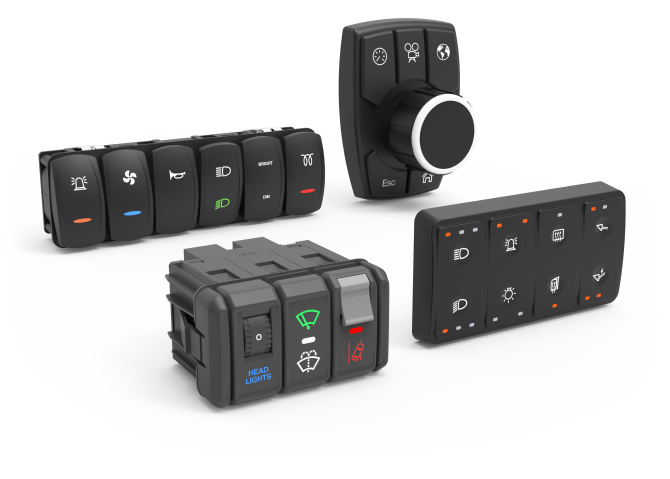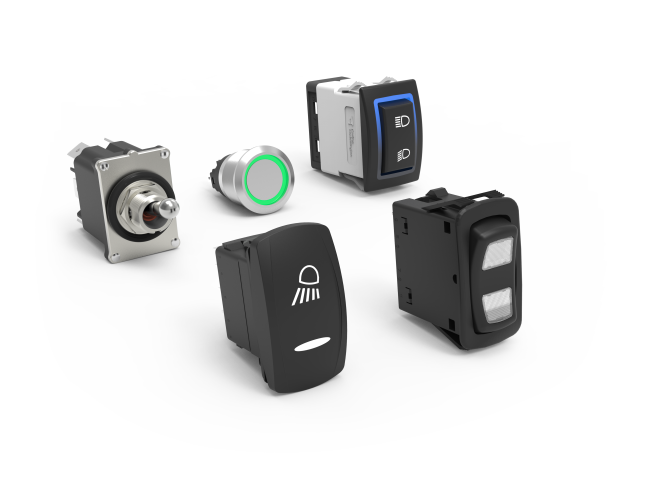
Switch it up!
By Carling Technologies
Circuit Protection Electronics Circuit protection switchesHow to choose the right switch for your design
Switches are the most fundamental component in any circuit and will often be the most important design decision a product designer makes when engineering the human/ machine interface.
If you get this choice wrong, the results can range from inconvenience through poor haptics all the way to compromised equipment and operator safety. Where should the designer begin? The following article provides an extensive set of useful guidelines for engineers and product designers looking for a head start.
The basics
Ask any design engineer what the key constraints are in any project, and you’ll hear the same two factors at the top of the list: cost and time. Often, there are constraints on both, but behind the need to deliver on-budget and on-time is the assumption of performance. For electrical switches in on- and off-road motive power applications, it’s even tougher. The process begins with the prime function of any switch: circuit performance:
- Will the switch control load directly or indirectly?
- Will the switch control ac, dc, or pulsed dc currents?
- Is the switched current subject to transient spikes or unusual inrush conditions?
- Is switch capacitance and internal resistance a factor?
For the engineer designing switches to go into an operator control station or console, these issues aren’t apparent from a schematic or functional block diagram. It’s essential for the design engineer to work closely with the circuit designer to ensure that a specified switch fits the entire performance envelope. That envelope may include RFI shielding due to other on-board systems including communications equipment and inductive pickup from spark ignition systems in gasoline engines.

To a product engineer, a switch is a physical device with associated volume, mass and pinout/connector arrangement attributes that must be considered in any design.
That’s easy to say, but few designers of panels and consoles are also circuit developers. This adds a responsibility to the engineer specifying the switch to work closely with the circuit design team to clearly define performance parameters in both normal and possible failure modes to narrow the selection process. Crossing that checklist against switches available that will fit panel design and cost considerations is the second major challenge facing the console/HMI designer.
At this point, it is highly recommended to contact the switch supplier as early as possible in the design phase.
Panel performance
For an electrical engineer or circuit designer, the switch is a schematic diagram symbol; however, for a systems or mechanical engineer, a switch is a physical device with associated volume, mass and pinout/ connector arrangement, among other attributes. “DPDT, 12A, 12Vdc” is a basic schematic specification, but the mechanical engineer or system designer also considers the human factors problem. These performance questions typically include:
- What type of switch? Toggle, rocker, rotary or push? Touch sensitive, or reconfigurable?
- What service temperatures can be expected? What about vibration and shock?
- Will the switch be exposed to moisture/immersion/washdown?
Chemicals, dust or ice? While the latter points are reliability factors, reliability and service are defined differently by different manufacturers. Many rely on existing standards organizations, such as the ASTM and SAE and require a corresponding paper trail of certification from the switch manufacturer In this context, the experience and reliability of the switch vendor is essential. For OEM applications, initial certification will likely be requested by the customer and the quality assurance (QA) process may require ‘certs’ on an annual, or even per shipment, basis. In addition to QA driven certifications, a user may require certification from independent, recognized third parties.
Certifications
UL/CSA are well-known certification bodies in North America and have some harmonization with European Union EN standards. German TuV and VDE standards also have wide acceptance in the Western world. In some markets, such as the European Union, end-of-life considerations must also be taken into account. For example, is the switch RoHS certified? It’s not just about mercury anymore; even a cadmium plated mild steel internal part can be an issue today, making this one of the many factors designers must consider today. Will the product be sold globally? If not, will this change in the future? If that happens, what is the cost of recertifying electrical components to global standards?

UL/CSA are well-known certification bodies in North America and have some harmonization with European Union EN standards.
It may make sense to choose a switch with cross-approved certifications right from the start. On highway equipment for on-road use the switch may require specific certifications, such as the harmonized CE mark. In every case, the design engineer needs to know which potential markets the unit may be sold to. Even if third party certification is not required, could it replace expensive in-house testing? Could use of third-party certified switches add perceived value to the product or offer a unique selling proposition? It may make manufacturing and marketing sense to specify certified switches even if they’re not required.
Can the switch vendor supply products with worldwide certifications? On the quality side, can they supply documentation to the satisfaction of both in-house QA and the end-user? It’s a crucial consideration and is one factor built into the price of a switch. Often, the lowest cost switch ships with little or no documentation or traceability. A simple measure of reliability would be a requirement for zero failures over the expected life of the switch, measured in switch cycles.
For some applications, mean time between failure – usually expressed in operating hours – might be requested. Again, the vendor represents the best starting point for switch selection where reliability considerations are paramount. Long life, high reliability switches are naturally more expensive, and a specifying engineer on a budget – essentially every engineer – can reduce costs and broaden the possible switch selection by sensible MTBF or reliability parameters.
It’s tempting to over-specify reliability in a complex system with multiple possible points of failure.
From a systems approach, however, the statistical analysis of circuit failure probabilities of each node may suggest tighter reliability specifications for other systems, such as wiring harnesses or connectors, therefore allowing lower cost switchgear. Overall system reliability is what counts; adding two orders of magnitude better failure probability to console/cockpit switchgear may be needlessly costly. Another solution is to manage switch failure to lower costs. Panel design using easily field-replaceable switches may allow the designer to achieve overall system reliability targets with a lower-cost switch. If field serviceability of operator panels or consoles is a product design requirement, the engineering for switch access may already be in place.
User performance
At this point, the designer may have a short list of switches that can perform in the circuit and at the desired level of reliability. Although switches are the most basic form of HMI, as soon as the human operator is factored into the system, another set of parameters must be considered. Typical questions might be:
- Can your operator actuate the switch conveniently? Will the operator be expected to look at the switch when actuating it? Will the operator be wearing gloves? Will they be in a high vibration environment?
- Does the operator need confirmation of switch actuation? Strong, defined detente positions? Power-on illumination?
- Will the switch be part of a multi-switch panel? Will the switches be directly or indirectly illuminated? Should brightness be controlled? Is the operator’s night vision an issue?
- Are specialized switches needed for safety critical functions?
Should some switches be interlocked or guarded?
- Is flame retardancy and safe failure modes a safety requirement? Must the switch fail open circuit? Can the operator inadvertently break the switch?
These are functional considerations, but most designers operate in highly competitive markets. Switches must do more than work reliably; they must create a productive work environment for the operator and add a perceived level of value to the overall system.
Design for manufacturability
By this point, a design engineer may have a good idea what to specify, but what about manufacturing? High performance and low cost at the component level is wasted if switches can’t be productively assembled in the panels on the assembly line. Before World War II, it was common to specify toggle switches mounted in sheet steel panels through punched half-inch holes with bezels and jam nuts. Surprisingly, that’s still an option today, but few modern designers would consider the slow and error-prone technology for volume applications.
Manual or automated through-panel insertion of switches without fasteners is the norm, mounting through rectangular apertures in stamped or injection molded panels. Rectangular mounting holes guarantee alignment, eliminate rotation and allow the panel designer to tool up at moderate cost.
For multiple switch panels, complete modules are usually the lowest cost option for volume applications, and add savings with simplified connectors and simpler, lighter wiring harnesses. The same cost pressures affecting the control designer are also at play in the rest of electrical system, and multiplexing – especially through communication protocols like SAE J1939 and NMEA – allow simpler, lighter harnesses.
For the control designer, the added complexity of multiplexing actually simplifies the panel problem, allowing an essentially infinite choice of custom or off-the-shelf control modules using touchpads with custom graphics and illumination.
———————–
Carling Technologies is a switch and circuit breaker manufacturer with registered manufacturing facilities and technical sales offices in Plainville CT.
